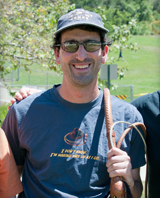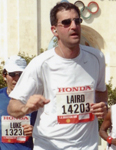
-CIA- World Factbook
-Cool Antarctica
-Discovering Antarctica
-FrankHurley.org

Laird's Bio

Follow Laird at
RunLairdRun.com

Support One of
Laird's Charities
Chapter 10 | Chapter 11 | Chapter 12

Aloha from Antarctica! Well not exactly Hawaiian weather down here, but the mood remains upbeat on the MV Sea Spirit two days after the 12th running (slogging?) of the Antarctica Marathon.
Weather has so far not been kind to us today. While the temperature hovers nears 32 F (0 C), the winds push the ship to starboard as we cruise in and out of this natural harbor. Those winds, blustering up to 50 knots, inhibit our ability to drop the Zodiacs into the water for our landing on the actual Antarctic Continent (as compared to the various offshore islands that have hosted us to date). This delay and preferably not cancellation of landing affords me the chance to file another Adventure Log Update.
First, let me tell you about the race itself. I'll give a short update here. For a complete course description, please see my blog at www.runlairdrun.com in the post race report entry.
Overall, the race went very well. If you have seen the Twitter updates, then you know I came in just under 4 hours, 26 minutes. This slotted me in at 9th place out of 78 marathon finishers - top 12% which is pretty much how I measure myself in races. If I am in the top 15%, then I am doing well. The time in fact does not tell the story of the race very well since it is some 25 minutes slower than my previous slowest time. Still, I was amazed and happy to receive the top finisher award in my age bracket (40-49)! I'll even get sent an engraved plaque after the race.
I feel I ran a very smart race overall and took advantage of my current interest in ultramarathons. An ultramarathon is any race longer than a standard 26.2 mile (40.1 km) marathon. I completed my first 31 mile (50 km) event in February 2010, and my second such event is less than six weeks ahead. One thing I learned when training for my first ultra is that you let the course dictate how you run. If you hit a super steep section, you walk. The energy expended forcing yourself to run a hill rarely pays off in the finishing time. Same goes for the windy sections. In fact, going all out early on the hard parts could translate into bailing out of the race due to fatigue or injury. So, you train yourself to modify your pace as you go and to switch gears quickly.
The course laid out for us by the intrepid race staff certainly demanded those shifts in pace. A mixture of hard packed dirt (we liked that!), loose stones (ok for running), small streams of glacial run off (lots of long jumps needed) and huge stretches of sticky mud (walking slowly demanded) challenged us at every turn, hill and dip. We ran two-and-one-half out-and-backs in these conditions with winds gusting up to 35 knots (40 mph). Sometimes those winds pushed us along, and at other moments the wind smacked into us with gale force intensity. The one complaint I could make was that the track never had any place that really opened up and let us run. But, if I wanted an easy surface, perfectly groomed, I could run the LA Marathon. (Oh, I am doing that too in less than three weeks.)
Overall, my time was 45 minutes slower than my 3:40 average. The marathon organizers tell you to expect 60 minutes slower, so another measure of my solid race was being below that delta. And yet, the times and course conditions say nothing about how FUN this event was to complete. First and foremost, I ran a marathon in Antarctica. Antarctica! How many people have even ever been here? Less than 100 years ago, there were not even any sort of permanent structures. Roads? Buildings? People? Try nothing but penguins and seals. Of course, now we have bases and research stations and roads. They are here so we can run the marathon, right?
Second, because this event is organized around a tour of Buenos Aires and Antarctica, I knew everyone on the course - the runners, the event staff, the course officials - everyone. Some people have become friends but there was not one face I did not recognize and who did not know me in return. With the course's out-and-back structure, we passed each other numerous times. Sure, competition entered into people's minds, but every passing offered another chance for a wave, a smile, a word or fist pump.
Lastly, the event is really well run. We have number bibs, and mile markers and flags lined the course to guide us along our way. Thom Gilligan, who owns and runs Marathon Tours & Travel, pioneered running in the Antarctic, and that experience provided all of us a safe, exciting, unique and nutty race.
Next up: The Marathon behind us, all focus turns to exploring Antarctica and learning about the history and wildlife.
Back to the Top
Chapter 10 | Chapter 11 | Chapter 12


